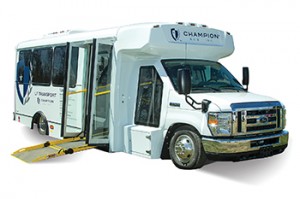
Technology drives accessibility
By Ryan Lamb
Since the advent of the Americans with Disability Act (ADA) of 1990, accessibility for people with disabilities who rely bus transportation is evolving steadily toward a state of equal access for all passengers; those with mobility challenges using walkers, wheelchairs and scooters, to mothers with strollers, to the elderly.

Equal access is in its infancy in terms of an industry segment. Passengers are still being loaded in and out paratransit buses on lifts in the back, and have no idea that technology exists for a more comfortable and dignified ride — until they actually experience this themselves.
However, a number of bus builders have worked diligently to improve the bus experience for all passengers. Champion Bus and Dallas Smith Corporation are among them.
The philosophy of equal access rests on sound engineering, innovative technology and precise mechanical function, with electronically controlled air-ride suspension as the foundation.
An air suspension system, such as the Champion IntelliSync® Smart system featured in Champion Bus’ LF Transport™ model, essentially allows transit agencies and private providers to serve all passengers in a vehicle everyone can appreciate. The overall comfort and stability of a paratransit vehicle equipped with air ride suspension surpasses standard leaf spring or coil suspension. The benefit is a consistently even ride height regardless of capacity, with the capability to raise the 2 to 3 inches in certain situations such as a steep driveway entrance.
Air-ride suspension is particularly robust in heavy-duty cycles, such as the rigorous schedule of an airport shuttle, which may go through 500 kneeling cycles picking up passengers curbside. It not only provides improved accessibility, but is also very dependable.
An air-ride suspension system allows another feature critical to equal access: the benefit of a self-leveling floor, which adjusts for weight imbalances from the air tanks positioned on one side of the bus and varying passenger loads. Additionally, electronic sensors are able to detect variations in ground level beneath the bus and make appropriate adjustments to level the floor of the bus.
This feature is extremely advantageous for passengers seated mobility devices, as it eliminates their concern for accidently rolling forward or backward, or having to negotiate a sloping floor. The components and tires wear evenly on a vehicle that is always stable and level, which also eases maintenance.

A uniformly-sloped entry ramp on an accessible vehicle eliminates the need for hazardous interior steps and cumbersome lifts, and is perhaps one of the best features of a bus designed for equal access. To the passenger rolling up the ramp onto a level floor, it is the essence of accessible. An entryway that is accessible for everyone does not segregate passengers using mobility devices, and is a more dignified way to enter and exit a transit vehicle than with a standard wheelchair lift.
This integral combination of systems and components that improve safety and comfort hits the mark for accessibility.
Ryan Lamb serves as product specialist of the LF Transport™ at Champion Bus, Imlay City, MI. Champion Bus, a subsidiary of Allied Specialty Vehicles, is one of the pioneers of the mid-size commercial bus industry and has been producing buses since 1981. Visit Champion Bus online at www.championbus.com.
